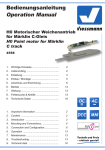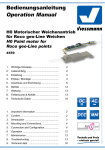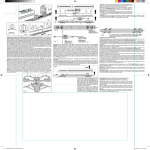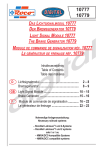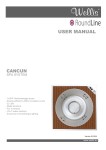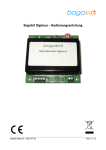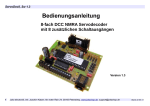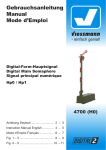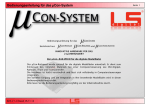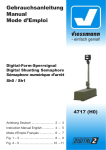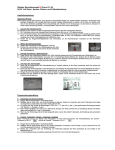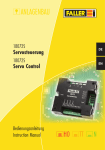Download Bedienungsanleitung - Viessmann Modellspielwaren
Transcript
Bedienungsanleitung Operation Manual 9500, 9501 0 Form-Hauptsignale zweibegriffig 0 Semaphore Block Signals two-aspect signals 1. Wichtige Hinweise...................................... 2 2. Einleitung................................................... 3 3. Einbau / Montage........................................ 5 4. Betrieb........................................................ 12 5.Wartung ...................................................... 14 6. Fehlersuche................................................ 14 7. Technische Daten...................................... 15 1. Important information .................................2 2. Introduction................................................3 3. Mounting and connection............................5 4. Operation.....................................................12 5. Maintenance...............................................14 6. Troubleshooting..........................................14 7. Technical data............................................15 DCC MM Rail Com DE 1. Wichtige Hinweise EN 1. Important information Bitte lesen Sie vor der ersten Anwendung des Produktes bzw. dessen Einbau diese Bedienungsanleitung aufmerksam durch und bewahren Sie sie auf. Sie ist Teil des Produktes. Please read this manual completely and attentively before using the product for the first time. Keep this manual. It is part of the product. Sicherheitshinweise Safety information Vorsicht: Verletzungsgefahr! Risk of injury! Aufgrund der detaillierten Abbildung des Originals bzw. der vorgesehenen Verwendung kann das Produkt Spitzen, Kanten und abbruchgefährdete Teile aufweisen. Für die Montage sind Werkzeuge nötig. Due to the detailed reproduction of the original and the intended use, this product can have peaks, edges and breakable parts. For installation tools are required. Stromschlaggefahr! Never put the connecting wires into a power socket! Regularly examine the transformer for damage. In case of any damage, do not use the transformer! Die Anschlussdrähte niemals in eine Steckdose einführen! Verwendetes Versorgungsgerät (Transformator, Netzteil) regelmäßig auf Schäden überprüfen. Bei Schäden am Versorgungsgerät dieses keinesfalls benutzen! Electrical hazard! Packungsinhalt überprüfen Checking the package contents Kontrollieren Sie nach dem Auspacken den Lieferumfang auf Vollständigkeit: Check the contents of the package for completeness after unpacking: - Signalmodell mit Antriebseinheit und einem im Kabel befindlichen Decoder, - model of the signal with drive unit and the decoder on the wires., - 2 Schrauben, - 2 screws, - ein Befestigungsclip, - one mounting clip, - eine Tafel mit selbstklebenden Bezeichnungsschildern, - a board with self-adhesive labels, - diese Anleitung. Das Produkt richtig verwenden Dieses Signal ist bestimmt: - Zum Einbau in Modelleisenbahnanlagen und Dioramen. - Zum Anschluss an einem Modellbahntransformator (z. B. Art.-Nr. 5200) bzw. an einer Modellbahnsteuerung mit zugelassener Betriebsspannung. - Zum Betrieb in trockenen Räumen. Jeder darüber hinausgehende Gebrauch gilt als nicht bestimmungsgemäß. Für daraus resultierende Schäden haftet der Hersteller nicht. 2 Caution: - this manual. Using the product for its correct purpose This product is intended: - For installation in model railroad layouts and dioramas. - For connection to an authorized model railroad transformer (e. g. item-No. 5200). - For operation in dry rooms only. Using the product for any other purpose is not approved and is considered incorrect. The manufacturer is not responsible for any damage resulting from the improper use of this product. Caution: Achtung: Die Antriebseinheit im Steuerkasten darf nicht geöffnet, beschädigt oder mit Feuchtigkeit in Verbindung gebracht werden. Der Decoder im Zuleitungskabel ist ebenfalls vor Beschädigung und Feuchtigkeit zu schützen. The drive unit in the control box must not be opened, damaged, or brought in contact with moisture. Please protect the decoder in the feeding cable from damage and moisture. 2. Einleitung 2. Introduction Viessmann-Formsignale zeichnen sich durch vorbildgetreu langsame Flügelbewegung, ihr hervorragendes Preis-Leistungs-Verhältnis sowie durch einfache Montage und einfachen Anschluss aus. Das vorliegende Formsignal verfügt über einen Digitaldecoder und einen motorischen Antrieb. Geschwindigkeit und Bewegungsablauf sind elektronisch gesteuert und gewährleisten einen feinfühligen Antrieb. Zusätzlich verfügt der Decoder über Ausgänge zur Zugbeeinflussung. Zudem kann das Signal bei der Abwärtsbewegung realistisch nachwippen (s. Kapitel 4). Viessmann semaphores have some outstanding benefits: Prototypical slow arm-movement, very good price-performance-ratio and they are simple to mount and connect. Viessmann-Formsignale haben sehr filigrane Masten, die sich durch eine perfekte Vorbildtreue auszeichnen. Daher sollten Sie das Signal nie am Mast anfassen, sondern immer nur an der Bodenplatte (Abb. 1). Bei einem Ausbau aus der Modellbahnplatte nicht oben ziehen, sondern die Elektronik unter der Platte greifen und nach oben hinausschieben! Abb. 1 Fig. 1 This signal has an electronic drive unit which controls speed and movement of the arm. Integrated switching-outputs can be used for train control. At the end of the downward cycle the signal bounces up and down a number of times before settling into position. (chapter 4) Viessmann semaphores have finely detailed metal masts, which are very sensitive. Therefore you should never touch the masts but only the ground plate for installation and deinstallation (Fig. 1). If you have to unmount the signal, don’t pull the signal mast. Carefully take the ground plate and gently push the electronic assembly through the mountiing hole. Abb. 2 Fig. 2 Hauptsignale stehen in Deutschland in der Regel in Fahrtrichtung gesehen rechts vom Gleis. Zweiflügelige Form-Hauptsignale können als Einoder Ausfahrsignale im Bahnhofsbereich oder als Blocksignale auf der Strecke eingesetzt werden. Adhesive signs are supplied with the signal. Simply cut out the desired sign and attach it to the signal box after removing the protecting foil. Here are some rules for the correct marking of the semaphore signals: Damit ein Lokführer Signale richtig zuordnen oder im Störungsfall die richtige Meldung machen kann, werden die Signale mit einer Buchstaben- / Zahlenkombination gekennzeichnet. Die Bezeichnung des Signals gibt zusätzlich Auskunft über seinen Standort. Hier einige Richtlinien zur korrekten Beschriftung: Signals are set on the right side of the track in Germany. Two-aspect-signals can be used in stations and on the route. Blocksignale: Selbstblocksignale werden mit arabischen Zahlen (1, 2, 3, …) bezeichnet. In Rich- Signals are marked with an alphanumeric combination. The name of the signal gives information about its position and direction of the route. Block Signals: These signals are labeled with arabic numbers (1, 2, 3, ...). In direction of the kilometre count, the signals are counted with odd num- 3 tung der Kilometrierung der Strecke wird mit ungeraden Zahlen vorwärts gezählt (1, 3, 5, …), in der anderen Richtung mit geraden Zahlen rückwärts (z. B. 6, 4, 2, …). Einfahrsignale: In Zählrichtung der Kilometrierung der Strecke werden für Einfahrsignale die Buchstaben „A“ bis „E“, in der Gegenrichtung „F“ bis „K“ verwendet. Ausfahrsignale: Ausfahrsignale, die in Zählrichtung stehen, werden mit „N“ bezeichnet. Ausfahrsignale, die entgegen der Zählrichtung stehen, werden mit „P“ bezeichnet. Hinter dem Buchstaben eines Ein- oder Ausfahrsignals steht die Ziffer des Gleises, für welches das Signal gilt. Damit Sie Ihre Signale korrekt beschriften können, liegt dem Signal eine Tafel mit selbstklebenden Bezeichnungsschildern bei. Schneiden Sie das gewünschte Schild aus, ziehen Sie die Schutzfolie ab und kleben Sie es auf die Nummerntafel am Mast des Signals (Abb. 2). Viele weitere Informationen über Signale finden Sie im Viessmann-Signalbuch, Artikel-Nr. 5299. Ansteuerung im Analogbetrieb Das Viessmann Form-Hauptsignal können Sie auch in analog gesteuerten Modellbahnanlagen einsetzen. Sie können es sowohl mit Wechselstrom als auch mit Gleichstrom betreiben. Entry Signals: In direction of the kilometre count of the route, the signals are labeled with the letters “A” to “E”, in the opposite direction “F” to “K”. Exit Signals: In direction of the kilometre count of the route, the signals are labeled with the letter “N”, in the opposite direction with “P”. Additional to the letter of an entry- or exit-signal stands the number of the belonging track. To label your railway signals correctly please use the attached adhesive labels: cut the number you have chosen for your layout, remove the protective foil, and put it on the signal post (Fig. 2). For further information concerning railway signals refer to the Viessmann signal book (item-No. 5299). Operation in analogue mode The Viessmann semaphore block signal can be used in analouge model railroad layouts. You may use AC or DC power supply for operation. The integrated controller and decoder recognizes automatically if there is AC or DC power supply or a digital signal and adjusts itself to the correct mode of operation. Overload protection Sobald Sie das Signal an Betriebsspannung anschließen, erkennt der integrierte Decoder automatisch, ob er analog oder digital angesteuert wird, und stellt den entsprechenden Betriebsmodus ein. If the signal recognizes a mechanical overload, it switches off to protect itself against destruction. The whole process of switching off may last up to a short time. Verhalten bei Überlastung Feedback with RailCom Bei mechanischer Überlastung schaltet der Decoder nach kurzer Zeit den Antrieb ab. RailCom is a protocol for bi-directional communication in digital model railway layouts controlled in DCC. It allows e. g. the feedback of the address or the requested position from the signal to the digital command station. Rückmeldung mit RailCom RailCom ist ein Zusatzprotokoll zur bidirektionalen Kommunikation in digitalen Modellbahnanlagen, die im DCC-Format gesteuert werden. Es ermöglicht z. B. die Stellungsrückmeldung des Signals zur Digitalzentrale. Das Versenden von RailCom-Nachrichten ist nur in Anlagen möglich, in denen ein DCC-Signal an den Schienen anliegt und seitens der Zentrale sowie des Boosters eine entsprechende Austastlücke im Datenstrom erzeugt wird. Daher ist die Nutzung der RailCom-Funktion in einer reinen Motorola-Umgebung nicht möglich. 4 bers (e. g. 1, 3, 5, ...). In the opposite direction the signals are counted with even numbers backwards ( e. g. 6, 4, 2, ...) Sofern der Decoder im Signal die Austastlücke registriert, sendet er nach einem erhaltenen Schaltbefehl als Quittung die Soll- und Ist-Stellung des Signals zurück. Sending RailCom messages is only possible in layouts with a DCC signal on the rails and if the command station and / or the booster(s) generate a cut-out in the digital signal. That’s why it is not possible to use RailCom in a Motorola system without DCC. Whenever the decoder registers the RailCom cutout, it answers the switching commands with the current state of the signal. In case of a moving motor, the estimated remaining movement time is reported. 3. Einbau / Montage 3. Mounting and connection 1. Beschriften Sie das Signal (siehe Kapitel 2). 2. Bohren Sie an der Montagestelle ein Loch mit einem Durchmesser von 13 mm (Abb. 3, passender Bohrer: Art.-Nr. 7801). 3. Führen Sie die Anschlusskabel einschließlich der Elektronik von oben durch das Montageloch. 4. Befestigen Sie das Signal mit den beiliegenden Befestigungsschrauben (siehe Abb. 4) bzw. mit dem Befestigungsclip (siehe Abb. 5). 1. Label your railway signal as described in chapter 3. 2. Drill a mounting hole at the position of your signal (diameter 13 mm; see Fig. 3). A convenient drill is available from Viessmann (item-No. 7801). 3. Thread the cable and the decoder in the cable from top to bottom through the mounting hole. 4. Fasten the signal post either with the attached srews (see Fig. 4) or with the mounting clip (see Fig. 5). Abb. 4 Abb. 3 Fig. 4 Fig. 3 13 mm Abb. 5 Fig. 5 Katalógusszám: Terméknév: Munkaszám: Szerszámszám: Tervező: Fekete János Dátum: 2012.02.22. Rajzoló: Fekete János Dátum: Ellenőr: 2012.02.22. Méreta.: 1.5:1 Név: Anya 9500 0- Haupt Dátum: 5 rot / red Abb. 6 Fig. 6 grün / green Universal Tasten - Stellpult 5547 braun brown 16 V Lichttransformator Primär 230 V~ 5200 Sekundär 10 V 0-10-16 V~ Primär 230 V 50 - 60 Hz Sekundär 52 VA max. 3,25 A IP 40 ta 25°C 0V gelb / yellow grün / green 5547 9500/ 9501 Nur für trockene Räume rot / red Gefertigt nach VDE 0570 EN 61558 5200 6 Werkseinstellungen Default settings Ab Werk ist der Decoder auf die Digitaladresse 1 (DCC-Protokoll) eingestellt. Weitere Konfigurationsmöglichkeiten entnehmen Sie bitte der CV-Tabelle auf den Seiten 10 und 11. The factory setting for the digital address is 1 (DCC protocol). Please find further configuration options in the CV table on the pages 10 and 11. Konventioneller (analoger) Betrieb Conventional mode of operation (analogue) Im konventionellen (analogen) Betrieb schalten Sie das Signal mit geeigneten Tastenstellpulten (z. B. Tastenstellpult Art.-Nr. 5547). In case that you use the Viessmann signal on conventional layouts, use a push button panel (e. g. Push Button Panel item-No. 5547). Schließen Sie das Signal und das Tastenstellpult wie in Abbildung 6 gezeigt an. Verwenden Sie einen geeigneten Transformator (z. B. Art.-Nr. 5200). Connect the signal and the push button panel as shown in figure 6. Use a suitable transformer (e. g. item-No. 5200). Digitalbetrieb Digital mode of operation Dieser Decoder lässt sich als Schaltartikel ansteuern. Er bietet aber auch den Komfort, auf einer Lokadresse angesteuert werden zu können. Dies kommt den Modellbahnern entgegen, deren Zentrale keinen bequemen Zugriff auf Schaltartikel ermöglicht. This decoder can be controlled as an accessory decoder. However, it also offers the option to be controlled with a locomotive address. This is particularly useful for modellers who do not have a command station with easy access to accessories. Im digitalen Betrieb schalten Sie das Signal über eine Digitalzentrale. Legen Sie als erstes eine Digitaldresse fest. Lesen Sie dazu die beiden folgenden Kapitel und beachten Sie Abb. 8. In the digital mode of operation, you use a digital command station to control the signal. Please read the following two chapters to learn how to set a digital address. Nach Festlegung der Digitaladresse schließen Sie das Signal an (Abb. 7). Connect the signal to your digital layout as shown in fig. 7. Einrichtung mit DCC-Zentralen Configure with DCC command stations Zur digitalen Steuerung des Signals müssen Sie diesem zunächst eine Digitaladresse zuweisen. Zur Steuerung im DCC-System gehen Sie wie folgt vor: To use the signal in a digital environment, at first you have to assign a digital address. To control the signal with a DCC-system, observe the following instructions: 1. Schalten Sie das Digitalsystem aus, z. B. NotAus. Es darf keine Spannung mehr am Gleis anliegen. 1. Switch off the digital system (e. g. emergency off). There must not be any power at the rails. 2. Verbinden Sie nur die rot markierte Steuerleitung und die Stromversorgungsleitungen des Signalantriebs (braun und gelb, s. Abb. 7) mit dem Gleis. 3. Schalten Sie das Digitalsystem ein. 4. Verbinden Sie nun die zweite (grün markierte) Steuerleitung gleichfalls mit dem Gleis (s. Abb. 8). 5. Senden Sie mit der Digitalzentrale nun für die gewünschte DCC-Adresse einen Schaltbefehl. Der Signalantrieb empfängt den Befehl, registriert die Adresse und quittiert dies durch Umschalten. Damit ist das Signal unter der neuen Adresse betriebsbereit. Falls Sie die Adresse künftig ändern möchten, wiederholen Sie die Prozedur einfach. 2. Connect only the blue wire with the red marker and the power supply wires of the signal (brown and yellow, fig. 7) to the rails. 3. Switch on the digital system. 4. Connect the second blue wire (green marker) to the track signal too (fig. 8). 5. Use the digital command station to send a turnout-request for the desired DCC-address. The decoder receives the request, registers the address as its own and as a receipt, it switches the signal. The signal is now ready to be used with the new digital address. Whenever you want to change the address, you just have to repeat the described procedure. Programmieren am Programmiergleis Programming on the programming track Die Konfiguration des Signals können Sie auch direkt an dem Programmierausgang von Zentralen, die DCC-kompatibel sind, vornehmen. Verbinden Sie dazu die Anschlüsse des Signals wie in Abb. 8 gezeigt mit dem Programmierausgang Ihrer Zentrale. The configuration of the signal can also be accomplished by connecting it directly to the programming output of the command station. Simply connect the terminals of the decoder to the programming output of the command station as shown in fig. 8. Die Adresse des Signals wird in zwei CVs programmiert. In CV 1 steht das untere Byte (LSB) der Adresse, in CV 9 das obere Byte (MSB). The address of the drive is programmed in two CVs. Das Umrechnen der Adresse geschieht wie im Folgenden beschrieben. Wenn Sie eine Adresse zwischen 1 und 255 eingeben wollen, so schreiben Sie diesen Wert direkt in CV 1. Den Wert in CV 9 setzen Sie auf Null. Höhere Werte als 255 müssen aufgeteilt werden in das MSB und das LSB. Teilen Sie die gewünschte Adresse durch 256 und ermitteln Sie das ganzzahlige Ergebnis und den Rest. Beispiele: In CV 1 you set the lower byte (LSB) of the address, in CV 9 the upper byte (MSB). The address is established as described below. Write the address value directly into CV 1 if you wish to assign an address between 1 and 255. Set CV 9 to 0. Higher addresses than 255 must be split into the MSB and the LSB: Divide the desired address by 256 and determine the result without decimal points as well as the remainder. Examples: Adresse ganzzahliges Ergebnis Rest CV 9 CV 1 256 1 0 1 0 911 3 911-256*3=143 3 143 1025 4 1025-256*4=1 4 1 Die weiteren Einstellmöglichkeiten entnehmen Sie der CV-Tabelle. In CV 40 können Sie auch das Protokoll festlegen, auf welches das Signal später „hört“. Auf Befehle am Programmierausgang einer DCCkompatiblen Zentrale hört der Decoder immer unabhängig vom eingestellten Protokoll. Further programming options are listed in the CV table. You may also set the desired digital protocol in CV 40. The decoder will respond to commands of the programming output of a DCC compatible command station regardless of the set protocol. 7 Abb. 7 Fig. 7 9500/ 9501 MM / DCC Digitalzentrale Digital Command Station braun brown braun brown rot / red grün / green gelb / yellow Einrichtung mit Motorola-Zentralen Configure with Motorola central units Damit Sie das Signal digital ansteuern können, müssen Sie diesem zunächst eine Digitaladresse zuweisen. Zur Steuerung im Märklin-MotorolaSystem gehen Sie wie folgt vor: To use the signal in a digital environment, you have to assign a digital address at first. To control the signal with a Motorola-system, observe the following instructions: 1. Schalten Sie das Digitalsystem aus, z. B. NotAus. Es darf keine Spannung mehr am Gleis anliegen. 2. Verbinden Sie nur die grün markierte Steuerleitung und die Stromversorgungsleitungen des Signals (braun und gelb, s. Abb. 7) mit dem Gleis. 3. Schalten Sie das Digitalsystem ein. 1. Switch off the digital system (e. g. emergency off). There must not be any power at the rails. 2. Connect only the blue wire with the green marker and the power supply wires of the signal (brown and yellow, fig. 7) to the rails. 3. Switch on the digital system. 4. Connect the second blue wire (red marker) to the track signal too (fig. 8). Abb. 8 Fig. 8 9500/ 9501 Adresse einstellen / Set address rotes Kabel verbinden / connect red cable DCC MM grünes Kabel verbinden / connect green cable gelb / yellow grün green 88 rot red braun / brown MM / DCC Digitalzentrale Digital Command Station 4. Verbinden Sie die zweite (rot markierte) Steuerleitung gleichfalls mit dem Gleis (s. Abb. 8). 5. Senden Sie mit der Digitalzentrale nun für die gewünschte Motorola-Adresse einen Schaltbefehl. Das Signal empfängt den Befehl, registriert die Adresse und quittiert dies durch Umschalten. Damit ist das Signal unter der neuen Adresse betriebsbereit. Falls Sie die Adresse künftig ändern möchten, wiederholen Sie die Prozedur einfach. Beachten Sie: Wenn Sie eine Zentrale einsetzen, die sowohl das DCC- als auch das Motorola-Format sendet, ist die Programmierung des Signals im DCC-Format empfehlenswert. Im Motorola-Format ist der Adressbereich auf 320 Adressen beschränkt. Digitalbetrieb auf einer Lokadresse Um den Decoder auf eine Lokadresse zu programmieren, gehen Sie wie folgt vor. Zunächst stellen Sie sicher, dass alle Lokomotiven auf Fahrstufe Null stehen. Bestimmen Sie, welches Digitalsystem verwendet werden soll. Gehen Sie dazu vor, wie unter den Punkten 1 bis 4 bei „Einrichtung mit DCC-Zentralen“ oder „Einrichtung mit Motorola Zentralen“ beschrieben. Stellen Sie alle Lokomotiven auf Fahrstufe Null, sofern Ihre Zentrale dies nicht automatisch tut. An Punkt 5 senden Sie jedoch keinen Signalschaltbefehl, sondern einen Lok-Fahrbefehl auf der Adresse, die der Antrieb bekommen soll. Betätigen Sie dazu den Fahrregler, sodass eine Fahrstufe an die Adresse gesendet wird, die nicht Null ist. Diese Adresse entspricht der Gruppenadresse eines typischen 4-fach-Decoders. Auf dieser Lokadresse wählen Sie dann eine Funktion F1 bis F4, die dadurch dem Signal zugeordnet wird. Somit können Sie 4 Signale auf eine Lokadresse legen, analog zum 4-fach-Decoder. Der Adressbereich ist auf 1 bis 99 begrenzt. Programmieren mittels POM Der Decoder lässt die Programmierung aller CVs per POM („Programming on the Main“, „Hauptgleisprogrammierung“) zu. Nicht alle Zentralen unterstützen POM Befehle an Schaltartikel-Decodern, deswegen kann man den Decoder auch auf Lokdecoder-POM Modus umstellen. Dies geschieht dadurch, dass auf der Adresse 9999 der Wert 80 in die CV 8 geschrieben wird. Der Signaldecoder hört dann auf normale POM-Befehle für Lokomotiven unter seiner aktuellen Adresse. Hier ist also Vorsicht geboten, damit nicht gleichfalls Lokomotiven, die diese Adresse haben, umprogrammiert werden. Gleichnamige Lokomotiven müssen entfernt werden oder der entsprechende 5. Use the digital command station to send a turnout-request for the desired Motorola-address. The signal receives the request, registers the address as its own and as a receipt, it switches the signal. The decoder is now ready to be used with the new digital address. If you want to change the address, you just have to repeat the described procedure. Notice: If you use a multiprotocol digital command station, which is able to use the Motorolaas well as the DCC-system simultaneuously, it is recommended to program the signal on a DCCaddress. Digital mode with a locomotive address Proceed as follows if you wish to programm the decoder to a locomotive address. Decide which digital system you are going to use. Proceed as described in points 1 through 4 in the chapter “Configurations with DCC command stations” or “Configuration with Motorola central units”. Set all locomtives to speed step 0 if your command station does not do that automatically. Instead of the accessory command as per point 5 send a locomotive driving command to the address to be assigned to this drive. Turn up the throttle in order to send a speed command greater than 0. This address corresponds to the typical group address of an accessory decoder with four doubleoutputs. Select one of the functions F1 through F4 of this locomotive address, which assigns the functions of this address to the signal drive. Thus you may control four signals with one locomotive address similar to a decoder for four accessories. The address range is limited to addresses from 1 through 99. Programming with POM The decoder supports programming of all CVs via POM (“Programming on the Main”). Since not all command stations support POM for accessory decoders you may also set the decoder to respond to the locomotive POM mode. Enter the value 80 in CV 8 of the address 9999. Then the signal decoder responds to normal POM commands for locomotives under the respective address. For safety you should first edit CV 1 and then CV 9, even if the value of CV 9 didn’t change. Please be careful to avoid inadvertent programming of other locomotives with the same address. Remove locomotives with the same address from the track or disconnect power to such track sections. If RailCom is active then the corresponding feedback will be sent to the command station. 9 Name der CV Name of CV Eingabewerte Erläuterungen / Hinweise (Default) value range Remarks Enthält die unteren 8 bit der Decoderadresse. Zusammen mit CV 9 wird so die Adresse gespeichert. Nur lesbar Contains the lower 8 bits of the decoder address. Thus the address is saved in conjunction with CV 9. Read only! Nur lesbar / Reset auf Werkseinstellungen. Durch Eintragen des Wertes 8 wird der Signalantrieb auf den Auslieferungszustand zurückgesetzt. Schreiben von Wert 9 setzt alle Werte außer die Adresse auf den Auslieferungszustand zurück. Obere 3 bits. Zusammen mit CV 1 wird so die Adresse gespeichert. Bit Kein RailCom 3 RailCom eingeschaltet 7 Decoder schaltet auf Lokfunktionen Read only! / Factory Reset. By entering the value 8 the signaldrive is reset to factory default values. Writing the value 9 resets all values except for the address to default values. Upper 3 bits. The address is saved in conjunction with CV 1. Wert 0 No RailCom RailCom turned on 8 0 Decoder responds to locomotive functions Decoder responds to 128 accessory commands Used by some command stations for reading of switch positions. 0 = normal, 1 = inverted LSB Adresse LSB address 1 0 … 255 (1) Versionsnummer Version number Hersteller Manufacturer 7 (1) 8 (109) Adresse MSB Address MSB Konfiguration configuration 9 0 … 7 (0) 29 (136) Signalstellung Position of the signal Richtung Direction Stellzeit in 100 ms Regulating time in 100 ms POM Programmierung POM programming 33 Stellzeit in 100 ms Regulating time in 100 ms Protokoll Protocol Nachwippen Shaking Lastregelparameter KP Lastregelparameter KI Lastregelparameter KD EMK Messungen EMF measurements 10 CVNr. No. 36 (0) 37 0 ... 50 (16) 38 (7) 39 0 ... 50 (7) 40 (0) 41 0 ... 1 (1) 42 43 51 52 53 54 Decoder schaltet auf Schaltartikelbefehle Wird von einigen Zentralen zur Auslesung von Signalstellungen benutzt. 0 = normal, 1 = invertiert Laufzeit des Antriebs in Schritten von 0,1 Sekunden für die Aufwärtsbewegung des Signals. 0: Inaktiv 1: Wenn eine Bewegung beendet wird, wird der entsprechende Ausgang kurz eingeschaltet. 2: Wenn eine Bewegung startet, wird der entsprechende Ausgang kurz eingeschaltet. 3: Ausgang zeigt den aktuellen Zustand an. Während der Bewegung sind beide Ausgänge aus. 4: Ausgang zeigt den aktuellen Zustand an. Während der Bewegung ist der alte Zustand angezeigt. 5: Ausgang zeigt den aktuellen Zustand an. Während der Bewegungen ist der neue Zustand angezeigt. 6: Decoderadresse + 1 schaltet die Ausgänge als Dauerausgänge um. 7: Bei einem Befehl in der Stellung “Halt” wird der Ausgang sofort kurz eingeschaltet. Bei einem Befehl in der Stellung “Start” wird der Ausgang nur nach dem Ende der Flügelbewegung aktiviert (Grundeinstellung). Laufzeit des Antriebs in Schritten von 0,1 Sekunden für die Abwärtsbewegung des Signals. 0 = DCC; 1 = Märklin Motorola Running time of the drive in step of 0.1 seconds for moving upwards. 0: inactive 1: Once a movement has finished the corresponding output is switched on for a moment. 2: If a movement commences then the corresponding output is switched on for a moment. 3: The output displays the current status. During movement both outputs are switched off. 4: The output displays the current status. During movement the previous status is still displayed. 5: The output displays the current status. During movement the new status is displayed. 6: Decoder address + 1 switches the outputs. 7: After a “stop” command the output is instantly activated for a moment. After a “go” command, the output is only activated after the movement of the signal arm ended (default setting). Running time of the drive in step of 0.1 seconds for moving downwards. 0 = DCC; 1 = Märklin Motorola (25) 0: Nachwippen inaktiv 1: Nachwippen wird am Ende einer Bewegung nach unten aktiviert. Höhe der ersten Wippbewegung. 0: shaking disabled 1: signal arm shaking enabled after a downward movement. Height of the first shaking movement. (18) Höhe der zweiten Wippbewegung. 0 … 255 (75) 0 … 255 (40) 0 … 255 (10) (8) Reglerparameter Height of the second shaking movement. Parameters for the motor load control. Anzahl von EMK Messungen, je Zyklus. Die ersten 2 Messungen werden automatisch ignoriert. Number of EMF measurements per cycle. The first two measurements will be automatically ignored. Name der CV Name of CV CVNr. No. Eingabewerte Erläuterungen / Hinweise (Default) value range Remarks Reglerperiode control period 55 (8) Gesamte Reglerperiode in 0,5 ms. Entire control period in 0.5 msec. Empfindlichkeit der Blockierungsdetektierung Sensetivity of blocking detection 56 (100) 57 (150) 58 0 ... 255 (255) 59 0 ... 255 (180) 60 0 ... 255 (120) 61 0 ... 255 (80) 62 (0) Zeit in 10 ms wie lange der Motor nach einer erkannten Blockierung weiter angetrieben wird. Es ist nur dann aktiv, wenn weniger als 3/4 des Gesamtwegs gefahren sind. In dem letzten Viertel wird der Motor bei einer Blockierung sofort abgeschaltet. Anzahl der Reglerzyklen nach dem Motorstart, ab wann die Blockierungsdetektierung aktiviert wird. Wird auf diesen Wert reduziert, sobald 1/8 des Weges absolviert wurden. Wird auf diesen Wert reduziert, sobald 6/8 des Weges absolviert wurden. Wird auf diesen Wert reduziert, sobald 7/8 des Weges absolviert wurden. Wird auf diesen Wert reduziert, sobald 8/8 des Weges absolviert wurden. Mit Schreiben des Wertes 206 wird eine Kalibrierung der Motorendstufe ausgeführt. Damit lernt der Decoder wie die Endpunkte der Bewegung sind. Time in 10 ms that the motor keeps running after having detected a mechanical resistance (blocking). It is only active if less than ¾ of the entire movement have been completed. In the last quarter the motor will be turned off immediately if blocked. Number of control cycles after the motor has started from which point on the motor blocking detection is active. Will be reduced to this value as soon as 1/8 of the movement has been completed. Will be reduced to this value as soon as 6/8 of the movement has been completed. Will be reduced to this value as soon as 7/8 of the movement has been completed. Will be reduced to this value as soon as 8/8 of the movement has been completed. The motor end stage is calibrated when writing the value 206. Thus the decoder “gets to know” the end positions of the required movement. Maximale Motorleistung maximal motor power Kalibration Calibration Stromkreis muss abgeschaltet werden. Unter RailCom werden die entsprechenden Nachrichten an die Zentrale gesendet. Die Schaltausgänge Die Schaltausgänge können auf verschiedene Funktionalitäten konfiguriert werden. Sie sind vorgesehen zum Schalten von Relais, können aber kleine Verbraucher wie LEDs auch direkt schalten. Stellungsrückmeldung per Relais Switch outputs The switch outputs can be configured to suit various functionalities (CV 38). The outputs are intended for relays, but can also power small loads such as LEDs. Feedback via relays The signal is equipped with a transistor-driven output, which is able to indicate the position of the Das Signal verfügt über zwei Transistor-Schaltausgänge zur Rückmeldung der Signalstellung. Abb. 9 Fig. 9 Schaltkontakte (als Lötflächen ausgeführt) Feedback outputs (soldering pads) 9500/ 9501 Max. Strom: 50 mA Max. current: 50 mA Elektr. Relais 5552 3 x blau / blue 11 In seiner Standardkonfiguration kann der Decoder damit beispielsweise bistabile Relais schalten. Der Kontakt wird jeweils am Ende des vorgesehenen Stellweges des Signals für ca. 250 ms eingeschaltet. Sie können über diese als Lötflächen ausgeführten Kontakte die Stellung des Signals an ein geeignetes Steuerungssystem zurückmelden oder Schaltvorgänge, wie das Abschalten der Gleisspannung oder das Umschalten auf geeignete Bremstechnik, wie Bremsgenerator oder ABCBremsung, auslösen. Aufgrund der geringen Belastbarkeit und der kurzen Schaltzeit nutzen Sie auf jeden Fall ein Relais wie z. B. das Elektronische Relais Art.-Nr. 5552. Zum Anschluss siehe Abbildung 9. Weitere Funktionen der Schaltausgänge Außer dem schon beschriebenen Schaltimpuls können die Ausgänge auch auf Dauerkontakt geschaltet werden. Dabei wird der jeweilige Ausgang am Ende der Bewegung aktiviert, wenn die Bewegung ordnungsgemäß abgelaufen ist, d. h. ohne Blockade des Antriebs. Weitere Möglichkeiten entnehmen Sie bitte der CV-Tabelle unter CV 38. Stellungsrückmeldung per RailCom Das Signal sendet über RailCom folgende Informationen an die Digitalzentrale: -Stellungsrückmeldung, -CV-Inhalt. 4. Betrieb Signal schalten Drücken Sie die entsprechende Taste auf dem Tastenstellpult (analoger Betrieb) oder senden Sie einen entsprechenden Befehl an die Adresse des Signalantriebs (digitaler Betrieb). Der Signalantrieb schaltet das Signal vorbildgerecht langsam um. Dies dauert etwa 1,5 Sekunden. Während der Stellzeit speichert der Antrieb einen weiteren Befehl, der eine andere als die aktuelle Stellung bedeutet und führt diesen nach einer kurzen Kühlzeit (ca. 0,5 Sek.) aus. Nachwippen bei Abwärtsbewegung Die Viessmann Flügelsignale 9500 und 9501 ermöglichen den Bewegungsablauf, den man beim Vorbild auch oft vorfindet, nämlich das Nachwippen der Signalflügel bei abfallenden Flügeln. 12 Für den schnellen und einfachen Zugriff, auch ohne Digitalzentrale, sind drei Bewegungsprofile in der Steuerung hinterlegt, die einfach abgerufen turnout. This output is used to operate latching relays. The contact is turned on for approx. 250 ms, when the signal reaches its respective end position. With these contacts (soldering pads on the back of the casing), you can use the information about the position of the signal to switch off the rail voltage, or in other control systems, for example a brake generator. Due to the low maximum load of the contacts and the short pulse length, it is important to use a relay (e. g. the Viessmann electronic relay 5552) as shown in figure 9. Other functions of the switch outputs Besides the switch pulse already described, the outputs can also be set to continuous mode with various commands (refer to CV 38). The outputs can be digtially switched as continous outputs. The address of the output is then automatically the decoder address plus 1 (see CV 38). You will find more options under CV 38 in the CV table. Feedback via RailCom The signal sends via the RailCom protocol the following information to the digital command station: - aspect of the signal, - CV contents. 4. Operation Operating the signal Press the appropriate button on the push-buttonpanel (analogue use) or send an appropriate request / order to the address of the signal (digital use). The signal drive turns now the signal with a realistic speed. This operation lasts approx. 1.5 seconds. During this operation, the signal saves another request / order, if this means another position and executes it after a short pause of about 0.5 secs. Signal bouncing at downward movement Viessmann semaphore signals 9500 and 9501 allow the simulation of the typical bouncing effect for the downward movement of the semaphore arms. Regarding the prototype semaphore signals you can observe a little movement upwards – caused by the unlocking mechanism – followed by the downwards movement of the semaphore arm. When “falling down”, the weight of the semaphore arm leads to a bouncing movement. werden können. Profil 1: „Nachwippen gering“ hat eine langsame Aufwärtsbewegung und zwei leichte NachwippVorgänge am Ende der schnelleren Abwärtsbewegung. Profil 2: „Nachwippen deutlich“ hat eine noch mal schnellere Abwärtsbewegung und zwei größere Nachwipp-Vorgänge am Ende der Bewegung als bei Profil 1. Profil 3: „kein Nachwippen“ hat eine langsame Aufwärtsbewegung und eine etwas schnellere Abwärtsbewegung ohne Nachwippen. Diese Profile können Sie leicht nacheinander aufrufen und das Ihnen angenehmste Profil auswählen. Gehen Sie dazu folgendermaßen vor: Verbinden Sie die Stromversorgungsanschlüsse des Signals mit einem Transformator (z. B. Art.-Nr. 5200). Verbinden Sie nun die beiden Steuerleitungen des Decoders miteinander und legen Sie sie an einen Transformatorausgang. Das Signal beginnt nun nach ca. 1,5 Sekunden mit den Bewegungen für Heben und Senken der Signalflügel entsprechend dem nächsten Profil. Bei einem fabrikneuen Signal ist dies Profil 1, d. h. „Nachwippen gering“. Diese Bewegung wird nun bis zu fünfmal nacheinander ausgeführt. Wenn Sie die Steuerleitungen vom Trafo trennen und wieder anschließen, wird nach ca. 1,5 Sekunden das nächste Profil aktiviert, also das Profil 2 „Nachwippen deutlich“. Auch dieser Bewegungsablauf wird bis zu fünfmal nacheinander ausgeführt. Das dritte Profil erreichen Sie genauso, d. h. Steuerleitungen abtrennen, Steuerleitungen wieder anschließen und Sie sehen das dritte Profil „kein Nachwippen“. Wenn Sie die Steuerleitungen erneut abtrennen und wieder anschließen, wird weiter geschaltet zum Profil 1 und alles wiederholt sich zyklisch. Sie haben also genügend Zeit, die Bewegungsabläufe anzuschauen und den zu wählen, der Ihnen zusagt. Das Profil wird jeweils direkt gespeichert. Wenn Sie also das Signal vom Strom trennen oder die Verbindung der Steuerleitungen auftrennen und normale Stellbefehle auslösen, dann ist das Profil ab dem Moment dauerhaft wirksam. Ein auf diese Weise ausgewähltes Bewegungsprofil ist auch bei Ansteuerung im Digitalbetrieb wirksam. Wenn Sie eine Digitalzentrale besitzen, können Sie den Bewegungsablauf individuell in vier CVs anpassen. Sie können die Geschwindigkeit, mit For fast and simple use – even without a digital control system – three different motion sequences are stored in the memory chip of the signal: Profile 1 “weak bouncing” a slow and short movement upwards, a fast movement downwards with two soft bouncing movements. Profile 2 “high bouncing movements” a slow and short movement upwards, a faster movement downwards with two considerable bouncing movements. Profile 3 “no bouncing” a slow and short movement upwards, a fast movement downwards with no bouncing movements. To select the motion sequence you prefer: Connect the 2 electrical power supply cables of the semaphore signal to the 2 power supply contacts of your transformer (e.g. item-No. 5200). Connect the two data line cables of the semaphore signal to each other and afterwards connect them both to one of the two power supply contact of the transformer. After about 1.5 seconds the semaphore arm starts moving in one of the three possible motion sequences - up to five times. Having a new signal this means starting with profile 1. Disconnecting the 2 data line cables from the transformer means that the motion sequence will be stored in the semaphore signal´s memory chip. Connecting the two data line cables to the transformer again means that after 1.5 seconds the semaphore arm will start moving – now with the different motion sequence. Disconnecting the data cables of the semaphore signal from the transformer means that now the motion sequence you have just watched before is stored in the semaphore signal´s memory chip. Repeat these steps until you have found the motion sequence 1, 2 or 3 you prefer. Remove the 2 electrical power supply cables of your semaphore signal from the power supply of your transformer. The motion sequence you have chosen is now stored in the memory chip of your semaphore signal – even without power supply. Now you can operate your semaphore on your layout in the chosen motion sequence mode. The selected profile is also valid in digital mode. The use of a digital control system allows the variation of even more settings by changing CVs: the velocity of the semaphore arm moving upwards, the velocity of the semaphore arm moving downwards and the amplitude of the bouncing movements. For more details please read the detailed instructions on the pages 10 and 11. 13 der die Signalflügel angehoben und wieder abgesenkt werden, in zwei CVs einstellen, ebenso können Sie den Hub für die erste und für die zweite Wippbewegung einstellen. Die CV Tabelle auf den Seiten 10 und 11 gibt weiteren Aufschluss darüber. 5. Wartung Achtung: Zerlegen Sie niemals den Signalantrieb. Zerstörung des Antriebs oder Verletzungen können die Folge sein. Der Viessmann Signalantrieb ist wartungsfrei. Notice: Never dismantle the signal drive. This may result in damage or injury. The Viessmann signal drive is maintenancefree. 6. Fehlersuche 6. Troubleshooting Jedes Viessmann-Produkt wird unter hohen Qualitätsstandards gefertigt und vor seiner Auslieferung geprüft. Sollte es dennoch zu einer Störung kommen, können Sie anhand der folgenden Punkte eine erste Überprüfung vornehmen. Testen Sie jedoch zuvor die Stromzuführungen. Every Viessmann product is manufactured under high quality standards and is tested before delivery. If there is a fault nevertheless, you can do a first check. At first check the power supply. Sollte das Produkt beschädigt sein, geben Sie es in der zugehörigen Verpackung zu Ihrem Fachhändler oder senden Sie es direkt an den Viessmann-Service (Adresse siehe unten). 14 5. Maintenance If the product is damaged, send it in the original package directly for repair to your local dealer or to the Viessmann service department (see below for address). Signalantrieb wird sehr heiß und/oder beginnt zu qualmen. Signal is getting very hot and / or starts to smoke. - Trennen Sie sofort die Verbindung zur Versorgungsspannung! - Prüfen Sie, ob das Signal gemäß Anleitung verkabelt wurde. - Prüfen Sie die Unversehrtheit des Elektronikgehäuses. - Mögliche Ursache: Kurzschluss. Das Signal wurde nicht ordnungsgemäß angeschlossen. - Mögliche Ursache: Die Isolation des Decoders im Zuleitungskabel wurde beschädigt und ist mit Metallteilen in Berührung gekommen. - Disconnect the system from the mains immediately! - Check if the wiring was made correctly as shown in this manual. - Check the state of the electronics enclosure for damage. - Possible cause: Short circuit. The signal was not connected correctly. - Possible cause: The electronics enclosure is damaged or is in contact with metal parts. Signalantrieb schaltet in falscher Richtung. Signal drive moves in the wrong direction. - Prüfen Sie ob das Steuerkabel gemäß Abb. 7 für normale Schaltung angeschlossen wurde. - Prüfen Sie ob die CV 36 richtig programmiert wurde. - Check the wiring of the control cables as per fig. 7. - Check if CV 36 is programmed correctly. Signalantrieb schaltet nicht. Signal drive does not operate - Prüfen Sie zunächst im Analogbetrieb, ob das Signal arbeitet. Falls ja, so gibt es wahrscheinlich einen Fehler bei der Adress- oder Proto- - First check if the drive works in annalogue mode. If it does then the most likely cause is an error in the address or protocol programming. kollprogrammierung. Wiederholen Sie diese. Ggf. setzen Sie das Signal auf die Werkseinstellungen zurück (CV 8 auf Wert 8 programmieren). Unerwartete Wippbewegung am Ende der Abwärtsbewegung. - Das Signal ist ab Werk auf „leichtes Nachwippen“ eingestellt. Sie können auf einfache Weise zwischen den drei Betriebsarten „Nachwippen gering“, „Nachwippen deutlich“ und „kein Nachwippen“ auswählen. Mittels CV-Programmierung können Sie Feineinstellungen am Bewegungsprofil selbst vornehmen. Wenn Sie die Fehlerursache nicht finden können, senden Sie das Signal bitte in der Originalverpackung zur Reparatur ein (Adresse s. u.). Repeat them and if necessary, reset the decoder to default values (programm CV 8 to value 8). Unexpected signal bouncing at downward movement. - This is typical for the prototype and therefore also a part of realistic Viessmann model semaphores. The standard factory setting for Viessmann semaphore signals is motion sequence 1 “weak bouncing”. To change this please select a different operation mode: either as described on page 13 or using a digital control system by changing CVs (see pages 10 and 11). If the product is damaged, send it in the original package directly for repair to your local dealer or to the Viessmann company (see below for address). 7. Technische Daten 7. Technical data Betriebsspannung (analog): 14-24 Volt ~/= Betriebsspannung (digital): max 24 Volt (eff.) Stromaufnahme (Ruhestrom): ca. 30 mA Stromaufnahme (im Schaltmoment): < 100 mA Operating voltage (analogue): 14-24 V ~/= Operating voltage (digital): max. 24 V eff. Current consumption (without load): approx. 30 mA Current consumption (switch moment): < 100 mA Datenformat: DCC und Märklin-Motorola Rückmeldeprotokoll:RailCom Data format: Feedback log: Kontaktbelastbarkeit (Rückmelderausgänge): Max. total current (feedback outputs): Schutzart: Umgebungstemperatur (Betrieb): Zulässige relative Luftfeuchtigkeit: 50 mA IP 00 +8 - +35 °C max. 85 % Die aktuelle Version der Anleitung finden Sie auf der Viessmann-Homepage unter der Artikelnummer. DCC and Motorola (MM) RailCom Protected to: Ambient temperature in use: Comparative humidity allowed: 50 mA IP 00 +8 – +35 °C max. 85 % The latest version of the manual can be looked up at the Viessmann homepage using the item-No. DE Modellbauartikel, kein Spielzeug! Nicht geeignet für Kinder unter 14 Jahren! Anleitung aufbewahren! NL Modelbouwartikel, geen speelgoed! Niet geschikt voor kinderen onder 14 jaar! Gebruiksaanwijzing bewaren! EN Model building item, not a toy! Not suitable for children under the age of 14 years! Keep these instructions! IT Articolo di modellismo, non è un giocattolo! Non adatto a bambini al di sotto dei 14 anni! Conservare instruzioni per l’uso! ES Artículo para modelismo ¡No es un juguete! No recomendado para menores de 14 años! Conserva las instrucciones de servicio! FR Ce n’est pas un jouet. Ne convient pas aux enfants de moins de 14 ans ! C’est un produit décor! Conservez cette notice d’instructions! PT Não é um brinquedo!Não aconselhável para menores de 14 anos. Conservar a embalagem. Modellspielwaren GmbH 87837 Stand 02/sw 12/2014 Ho/Za 15
















